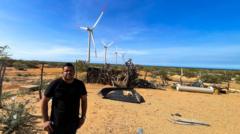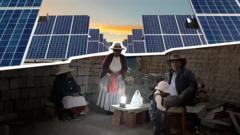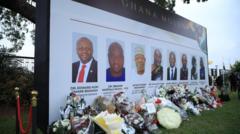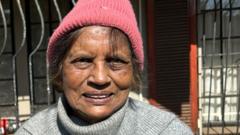The installation of wind farms in La Guajira, Colombia, is transforming the region's energy landscape, but the Wayuu indigenous community faces cultural and social dilemmas as they navigate the benefits and consequences of these developments. While some community members see improvements in infrastructure and resources, others raise concerns about the erosion of cultural practices and effective compensation for their land.
Wind Energy in Colombia: A Double-Edged Sword for Indigenous Communities

Wind Energy in Colombia: A Double-Edged Sword for Indigenous Communities
As Colombia pushes for renewable energy, wind farms in La Guajira present both opportunities and challenges for the Wayuu indigenous group.
When José Luis Iguarán steps outside his home in La Guajira, he encounters a skyline dominated by towering wind turbines reaching towards the Caribbean Sea. For the Wayuu, an indigenous group with a long-standing connection to this arid peninsula, the rapid development of wind farms represents both a promise of progress and a source of cultural disruption.
La Guajira's powerful winds have positioned it as the forefront of Colombia's transition from fossil fuels to renewable energy. However, this green shift has sparked mixed reactions among the local Wayuu community, whose historical practices include herding goats, fishing, and farming. "You wake up and suddenly you no longer see the trees; instead, you see and hear the turbines," reflects Mr. Iguarán, highlighting the emotional toll as modernity encroaches on tradition.
The Guajira 1 wind farm, the first of its kind in the region, has also become a contentious topic. While the energy company behind it, Isagen, has improved aspects of local life by providing essentials like clean drinking water and developing infrastructure, the noise from the turbines proves unsettling for the Wayuu. "At night, the noise from the turbines disturbs our dreams," shares Mr. Iguarán, emphasizing the cultural significance of dreams as sacred and a conduit to spiritual messages.
The sentiment is shared by Aaron Laguna, a fisherman from Cabo de la Vela, who underscores the growing divides within Wayuu communities regarding the benefits of wind energy projects. Local dissent stems from concerns about transparency, cultural disrespect, and ineffective compensation from energy companies. As negotiations over a new wind farm progress, disputes highlight varying opinions within the Wayuu, with some advocating for inclusion while others feel marginalized.
"There is still this idea that if it is green, it is automatically good," warns Joanna Barney, an environmental and community director at the think tank Indepaz. The lack of a comprehensive legal framework to evaluate the social and environmental impacts of these projects adds to local trepidations.
The complex landscape of wind energy in La Guajira has led to the withdrawal of international companies, such as EDP Renováveis, who faced challenges from a growing number of indigenous voices demanding to be heard. Their exit in December 2024 followed years of protests, revealing the discontent brewing within the communities against energy corporations.
Amidst escalating tensions, anthropologist Wieldler Guerra emphasizes a significant disconnect between the Wayuu worldview—where winds are regarded as living entities—and the commercial perspective of wind as merely a resource. This cultural clash complicates meaningful dialogues between indigenous communities and energy stakeholders, resulting in potential conflict as companies attempt to advance their projects.
Despite assurances from firms such as AES Colombia, which is embarking on the largest wind energy cluster in the area, the inherent risks remain. General Manager Federico Echavarría stresses a need for the government to mediate community conflicts and ensure fair practices.
However, not all local voices share in the anticipated benefits of this energy transition. Laguna points out the paradox of the situation: "The worst thing is we won't receive even a single kilowatt of the electricity produced here." Many in the Wayuu community continue to lack basic resources while the power generated is directed elsewhere.
In this landscape of competing interests, the future of La Guajira’s wind energy remains uncertain. For many Wayuu, the promise of renewable energy collides with their desire to uphold their cultural identity and secure a lasting share of the benefits flowing from the winds that have cradled their ancestors for generations.



















